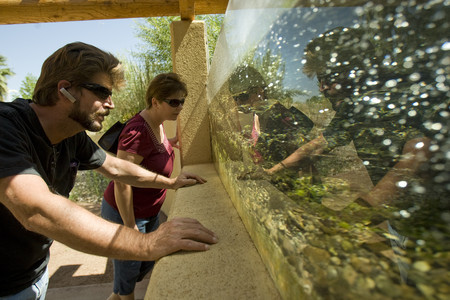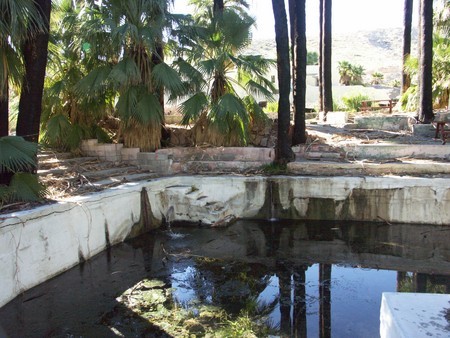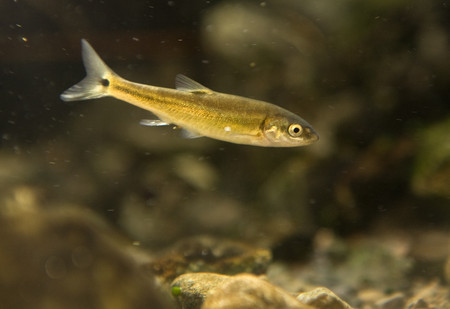Moapa dace fish make public showing
MOAPA -- Today marks the 30th anniversary of the Moapa Valley National Wildlife Refuge, but don't expect confetti or cake.
The U.S. Fish and Wildlife Service has no plans to mark the occasion, and for good reason: The 117-acre oasis for endangered fish isn't open on Thursdays.
Over the past three decades, in fact, the refuge, 60 miles north of the Strip, has scarcely been open at all.
Bruce Lund literally holds the key to changing that.
Lund is one of four volunteers who have teamed up to start opening the little-seen refuge from 9 a.m. to 4 p.m. Saturdays. The job mostly involves opening a gate in the chain-link and barbed-wire fence, then sitting alone near the gurgling water.
"We all have the keys," Lund said.
Moapa Valley National Wildlife Refuge was founded Sept. 10, 1979, on 30-odd acres at the headwaters of the Muddy River. Its mission hasn't changed in the decades since; it's still all about the dace.
A finger-length fish with the black dot on its tail, the Moapa dace lives in crystalline water that bubbles up from the deep carbonate aquifer at dozens of locations south of state Route 168.
Its entire habitat is just a few miles long, from the dace's spring-pool spawning grounds to the upper reaches of the Muddy's main stem.
The fish came under federal protection in 1967.
"I tell people it's a native Nevadan because you won't see it anywhere outside Nevada," said Cynthia Martinez, manager of the 1.6 million-acre complex of four refuges including Moapa Valley.
Martinez said unlocking the gates on Saturdays is a small step toward the goal of staffing and opening the refuge full time.
She couldn't say when that might happen, but she expects the necessary funding to come through eventually. "I wouldn't continue to work here if I didn't," she said.
The refuge didn't even have public facilities to speak of until 2007, when proceeds from the sale of federal land in the Las Vegas Valley helped pay for restrooms, picnic tables and a short, wheelchair-accessible walking path.
Money from the Southern Nevada Public Lands Management Act also paid for the refuge's signature feature: a viewing chamber -- basically a windowed cross-section of a spring-fed stream -- that provides an eye-level look at the dace in its natural habitat.
Martinez said they hope to have interpretive signs installed at the refuge by next summer, and plans are in the works for additional trails, stream restoration and revegetation work.
"I think people have a hard time grasping something if they don't get an opportunity to see it," she said.
Before there was a refuge, the once-private property housed several retreats built around spring-fed swimming pools: one of them Olympic-sized and another nicknamed the "Playboy pool" for a certain photo shoot that may or may not have occurred there.
Federal officials have spent the past several years tearing out old structures and thinning crowded stands of palm trees that, left unchecked, can choke streams and invite damaging wildfires.
The most recent project restored some natural spring pools and streams on 48 acres that was added to the refuge in 2000. Dace returned to the restoration area within three months of the work.
But habitat improvements have come at a cost. Some blame disturbances caused by restoration work for a recent drop in the dace population.
In 2007, biologists counted 1,172 dace in the waters on and around the refuge. The following year, the population plummeted to 459, by far the lowest number reported since the fish came under federal protection.
The dace appears to have rebounded slightly since then. The most recent count in August showed a total population 508 dace, a 10 percent increase since February.
The dace share the water with other rare and protected species, including tiny fish, snail and insects.
The refuge is also a draw for almost 90 types of native and migrating birds and 21 types of bats, as well as ringtail cats, coyotes and bighorn sheep.
"It's an exquisite example of what a natural spring system is -- or used to look like -- in the Mojave Desert," Lund said.
The refuge opened to the public for the first time on March 7. Volunteers kept it open one day a week until late May, when it shut down for the summer.
It began opening again on Saturdays last week, when Lund saw a larger than usual crowd: 20 people over the course of six hours.
"Most of the day there will be no one here. I can walk up and down these streams and watch the dragonflies and damselflies," said Lund, who lives in nearby Moapa and is spending part of his retirement writing a field guide about the insects. "If I get off my duff someday maybe I'll do the butterflies too."
But as much as he enjoys what he is doing, Lund said he would prefer to see Moapa Valley -- and the nation's refuge system as a whole -- get the funding it deserves.
"It's frustrating. Our priorities have got to change ... as a country," he said.
"I wish it was different. So does the Fish and Wildlife Service. All things being equal, they'd rather have people on the ground here," Lund said. "If I was in charge, they would."
Contact reporter Henry Brean at hbrean@reviewjournal.com or 702-383-0350.




















